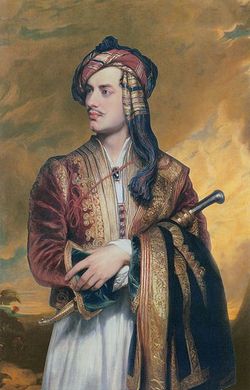Lord Byron: Difference between revisions
imported>Martin Wyatt (→Life: continuation) |
imported>Martin Wyatt (→Character: matter incorporated elsewhere) |
||
| Line 16: | Line 16: | ||
== Character == | == Character == | ||
His lifestyle as an extravagant aristocrat, along with his excesses in the field of love and his accumulation of huge debts made him one of the most talked about and fascinating personalities of his time | His lifestyle as an extravagant aristocrat, along with his excesses in the field of love and his accumulation of huge debts made him one of the most talked about and fascinating personalities of his time. | ||
==Works== | ==Works== | ||
Revision as of 14:24, 24 January 2014
George Gordon Byron, 6th Baron Byron (January 22, 1788 - April 19, 1824), called Lord Byron, or simply Byron, was an English romantic poet, known not only for his poetry, but also his very unconventional lifestyle and revolutionary attitude. The literary figure of the Byronic hero, marked by passion, talent and rebellion, pervades Byron's work and influenced later romantic poets. Due to his financial and personal engagement in the Greek War of Independence, Lord Byron is considered a national hero in Greece.
Life
The son of Captain "Mad Jack" Byron and his second wife, a Scottish heiress, Catherine Gordon, Byron was born on 22 January 1788. When he was three his father died, having wasted his wives' fortunes. At the age of ten he became the sixth Baron Byron of Rochdale on the death of his great-uncle, inheriting the family house of Newstead Abbey, stripped by the profligacy of his forebears. He went to Harrow and Cambridge, where he set about getting seriously into debt. While at Cambridge he produced his first serious publication, Hours of Idleness, mingling fairly conventional lyrics, free translations from Greek and Latin, and a tale or two, with some political and satirical pieces. Its sarcastic reception by the Edinburgh Review brought out Byron's satiric viciousness in English Bards and Scotch Reviewers, in which he attacked most living poets, and held up the classical authors John Dryden and Alexander Pope as models. It was a lively piece of work and sold well, but he later regretted his scathing opinions.
In 1809 he and John Cam Hobhouse set off for the Mediterranean, travelling by way of Portugal, Spain, where he visited the scenes of recent battles in the Peninsula War, Sardinia, Malta, and Albania (acquiring the clothing shown in the portrait) to Greece. After visiting Constantinople he parted from Hobhouse and went to Athens and other parts of mainland Greece. He returned to England with the draft of the poem which made him an unequalled literary sensation, Childe Harold's Pilgrimage.
Having started as a defender of the classical tradition, Byron now produced in the first two cantos ofChilde Harold a work that was vigorously romantic. It is largely a topographical poem, describing scenes that are wild, savage, or otherwise dramatic; but they are seen through the eyes of a particular individual, a melancholy aristocratic outsider, not too different from Byron himself. The effect was immediate. Byron wrote: "I awoke one morning and found myself famous." The poem made the fortune of his publisher/bookseller John Murray: but, although heavily indebted, Byron at this stage thought it not fittin to his aristocratic position to accept money for his poetry.
He was now lionised by London society, and became involved in sexual relationships with various women, including Lady Caroline Lamb, who later described him as "mad, bad and dangerous to know" (terms which might have been applied to herself), and his half-sister Augusta Leigh, his father's daughter by his first wife. He also met Annabella Milbanke whom he later married. His poetry at this time was most conspicuously in four "oriental tales", featuring moody Byronic heroes. These sold well, though a satire on London society did not. After his marriage in January 1815 he was working on Hebrew Melodies, a small collection of poems which had been requested from him. It included some of his most anthologised pieces: She walks in beauty, Oh snatched away in beauty's bloom, and The destruction of Sennacherib ("The Assyrian came down like a wolf on the fold").
The marriage ended in separation, based on (well-founded) suspicions of incest and homosexual activity with young men, and in 1816 Byron fled into voluntary exile.
Character
His lifestyle as an extravagant aristocrat, along with his excesses in the field of love and his accumulation of huge debts made him one of the most talked about and fascinating personalities of his time.
Works
Byron was an extremely prolific writer. In 1832 his publisher, John Murray, released Byron's complete works in 14 volumes in duodecimo, including a biography by Thomas Moore. Later editions were published in 17 volumes.
- 1806 Fugitive Pieces published privately
- 1807 Poems on Various Occasions published privately, Hours of Idleness published
- 1809 English Bards and Scotch Reviewers anonymously published
- 1811 'Hints from Horace' and The Curse of Minerva written (unauthorized publication in 1815)
- 1812 Childe Harold's Pilgrimage, Cantos I and II published, The Waltz written
- 1813 The Giaour and The Bride of Abydos published
- 1814 The Corsair and Lara published; Ode to Napoleon Buonaparte anonymously published
- 1815 Hebrew Melodies published
- 1816 The Prisonar of Chillan, The Siege of Corinth, Parisina and Childe Harold's Pilgrimage Canto III published
- 1817 Manfred published
- 1818 Beppo and Childe Harold's Pilgrimage Canto IV published
- 1819 Prophecy of Dante written, Mazeppa and the Ode on Venice published, Don Juan Cantos I & II anonymously published
- 1821 Marino Faliero, Sardanapalus, The Two Foscari, Cain and Don Juan Cantos III - V published
- 1822 Vision of Judgement and Werner published
- 1823 Heaven and Earth, Age of Bronze, The Island and Don Juan Cantos VI–XIV published
- 1824 Don Juan Cantos XV–XVI published
